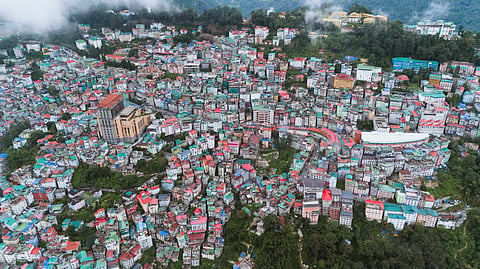

Perched on the eastern Himalayas, Gangtok is quietly scripting a story that few Indian capitals can tell, one of clean air, reduced traffic and people-first planning. In 2024, it recorded an average fine particulate matter (PM2.5) level of just 13.8 — making it the cleanest capital city in India, according to state officials. Unlike most urban centres grappling with rising pollution, Gangtok offers a compelling model of efficient mobility.
Despite population growth and ongoing construction projects, the city’s air quality has remained largely unaffected. According to the State Pollution Control Board, Gangtok’s Air Quality Index (AQI) remained in the “Good” to “Satisfactory” range throughout the monsoon and winter — the two dominant weather periods in the region.
The relative serenity of the city with a population of 144,000 is also a result of careful regulation. On November 5, 2024, the Sikkim government implemented an odd-even traffic rule within Gangtok’s municipal limits to address growing congestion. Under the system, odd-numbered vehicles are allowed to ply on odd dates and even-numbered vehicles on even dates, during two peak slots: 9.30 am to 12 pm and 3.30 pm to 6 pm.
A buffer period from 12.30pm to 3.30pm allows for exemptions and the rule applies specifically along the National Highway corridor between Mayfair Fatak and GICI, Zero Point. Feeder roads are excluded and emergency, essential, government and media vehicles are exempt.
Locals said that the rule, while restrictive at first, has led to a noticeable easing of traffic in the city centre. Some schools in and around the core city area have also adjusted their operating hours to reduce student exposure to rush-hour delays, helping save them time for more productive activities.
Restaurant-owner Yeshay Chopel Bhutia, experiences few issues due to off-peak commuting, but cites parking costs as a growing concern. “I rarely get stuck in traffic, but even monthly parking is expensive now,” he said.
In addition to tackling air quality, the state has also moved to curb noise pollution. In 2019, Sikkim declared several parts of Gangtok as “No Horn Zones”, citing powers under the Motor Vehicles Act. The ban applies to the areas around the Sikkim Legislative Assembly in Nam-Nang, New STNM Hospital in Socheygang, Central Referral Hospital in Tadong and the entire municipal stretch from Ranipool to Tashi View Point on NH-10. Authorities have been directed to strictly enforce the regulation, building on earlier orders from 2003 and 2004.
Mobility in Gangtok is largely supported by shared taxis, with cars accounting for over 53 per cent of the city’s mode share, shows analysis by Delhi-based think tank Centre for Science and Environment of data from the 2009 Comprehensive Mobility Plan for the city. The average speed of vehicles in non-peak hours is 20 kilometres per hour, which goes down to 8 kilometres per hour in peak hours, as per the data.
For some commuters like Sushmita Bhujel, a reporter who travels seven kilometres to work by taxi, traffic is a concern — especially during peak hours. “It’s troubling at times, but I’ve gotten used to it,” she says. “I just wish I didn’t have to rush through the same narrow bottlenecks every day.” Bhujel ends up spending about Rs 100 every day on commute, but is grateful that she doesn’t have to choke on smog like other major cities in the country.
Non-motorised transport, including walking, plays a surprisingly large role at 42.5 per cent, a reflection of the city’s compact geography and pedestrian-friendly stretches like MG Marg.
Two-wheelers make up just 2.4 per cent of the mode share, while public bus and metro services — where available — account for less than a per cent. Although the government operates bus services, these are primarily intended for routes extending beyond the city limits.
Government officials and staff typically commute using designated vehicles and buses operated by the state largely serve destinations outside the city core.
Looking ahead, there’s optimism around electric vehicle adoption. Chief Minister Prem Singh Tamang (Golay) recently announced a renewed push to electrify Gangtok’s transport network, though specific timelines and targets are awaited. Residents said they are hopeful this will reinforce the city’s clean air reputation in the years to come.
This article is part of our series on how India moves, which looks at the relationship between air quality and human mobility in cities and towns.